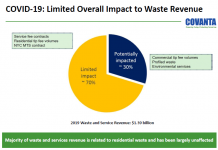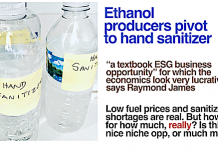Dana Blankenhorn
I am a big booster of alternative energy. Harvesting the wind, the Sun, the heat of the Earth, the tides – I’m there and NIMBYs be damned.
But I am increasingly having second thoughts about one type of green energy. Corn-based ethanol. (I would toss in sugar cane, too, but America doesn’t grow enough to matter here.)
Corn ethanol was one of the first biofuels to find a market. Pushed by companies like Archer Daniels Midland (ADM) and Cargill, corn ethanol is now an integral ingredient in many blends of gasoline. It is compatible with gasoline and, its advocates say, it burns cleaner.
But corn is a row crop. That means it’s planted in long rows. It’s dependent on man for its survival. (If we didn’t open the husks and spread the seed it would not exist.) Corn also takes nitrogen from the soil. It depletes the land. The way you sustain land for corn is by either spreading fertilizer every year or letting the land “rest” every so often, rotating it with soybeans or (better yet) some non-food crop such as a perennial grass.
Corn is also a food crop. The same process which leads to ethanol leads to corn syrup. Corn is an essential feed for livestock of all kinds. Corn ethanol competes with people and animals for corn.
All this makes corn an easy whipping boy for those who actually oppose renewable energy, like oil industry analyst Bob van der Walk.
“Using food for bio-fuels – especially in Western countries – is counter productive to keeping the price for those staples affordable, but that is exactly what is being encouraged by the proposed federal subsidies,” he writes.
He’s right. Support for corn is the Achilles Heel of the alternative fuels industry. And it doesn’t have to be that way.
As venture capitalist Vinod Khosla notes, concentrated hydrocholoric acid can break any plant material into its constituent parts, leaving it all available for use. Forest waste can be used to produce ethanol. So can switchgrass. Polyculture, growing several different kinds of plants in the same place, can become an economic source of cellulosic alcohol while reclaiming land row crops are making unusable.
The problem here is that cellulosic alcohol is not yet a proven technology. But that’s a technical problem. It should not be a political one.
The political problem here is not with the farmer – not if he has economic alternatives to corn that can supply energy. The political problem here is with the processors, with firms like ADM that have married corn to green politics and don’t want to change either business or political strategy. The processors are the financial support for politicians across the farm belt who are willing to stick their neck out for renewable energy. Remove that support and, it seems, their replacements would vote against us. Or they would.
It reminds me of the old “National Lampoon” cover from the 1970s – if you don’t buy this magazine we’ll kill this dog. The dog in this case is environmental politics, and ADM holds the gun.
It’s time for that company to disarm.
Under CEO Patricia Woertz, there have been some indications the company wants to do just that. A former Chevron executive, Woertz talks a good game, but the company’s stock has gone nowhere under her leadership and its prospects remain tied to the price of corn.
ADM has used government money for a demonstration cellulosic plant near its headquarters, and has worked with Purdue on research that would use all of a corn plant for energy production. But in this new game it’s only one of many contenders. In corn it’s king.
Is the best way to accelerate the move to truly renewable ethanol, to cellulosic alcohol, for the rest of the renewables industry to let ADM go?
Dana Blankenhorn first covered the energy industries in 1978 with the Houston Business Journal. He returned last month after a short 29 year hiatus because it’s the best business story of our time. In between he covered PCs, the Internet, e-commerce, open source, the Internet of Things and Moore’s Law. It’s the application of the last to harvesting the energy all around us he’s most excited about. He lives in Atlanta.









There is plenty of sugar cane in Australia (when we don’t have cyclones!) and other parts of the world.
This grows natrually in a more random fashion via shoots from the root system. I wonder if sugar cane is less depleting of the soil nutrients than corn?
Sugar cane is very destructive to wetlands, it’s harvested by hand (which is why Hawaii now lets it grow wild) and it’s only suitable in a very small part of the US. And, yes, it depletes the soil.